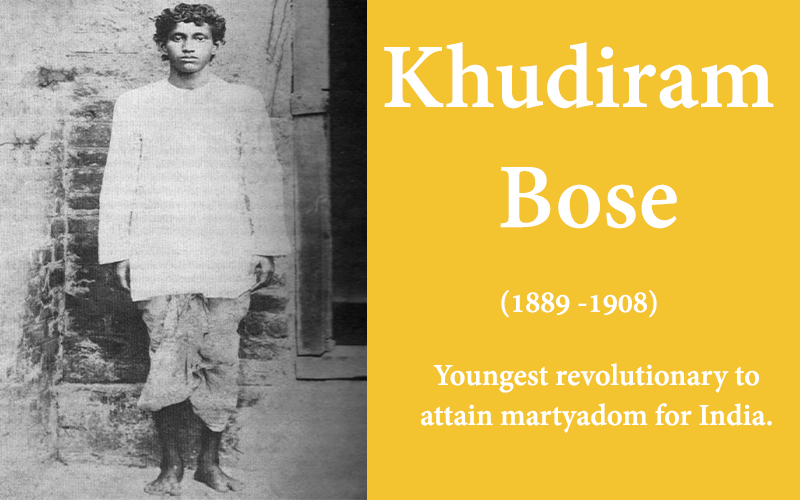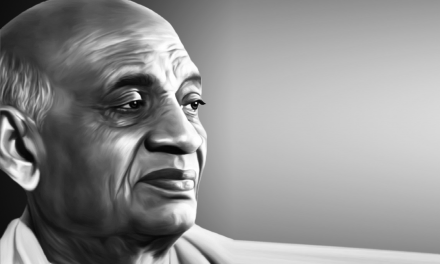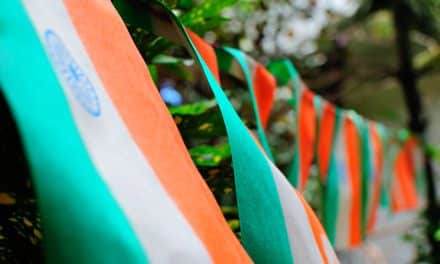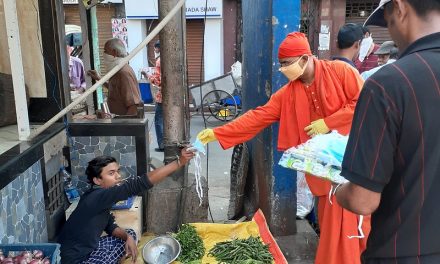As the state of West Bengal continues to be mired in a state of mal-governance and the political debate reduces to a binary of Secularism versus Communalism citizens are forced to delve into Bengal’s rich and disproportionate share of revolutionary icons who fired up the Indian Independence movement, to understand the ideological moorings of these brave group of men and women who trod a lonely tragic path. Sadly, in school history curriculum their contributions have been relegated to mere footnotes in italics as revolutionaries or extremists if not terrorists. The insidious and pervasive efforts to perpetuate the Gandhian way, as the only way, has led to a distorted mindset about what constitutes worthy aspirations.
A false illusion however idyllic should never be nurtured as it then exposes the society to brutal reality which can be horrific when the illusory dream is ruptured. A case in point is the idealisation of the ground reality of peoples’ lives in the Soviet Union, the dissolution of which fragmented the erstwhile USSR exposing an entire generation to untold economic misery for which they were not equipped at all. A more recent example is the dissolution of Baathist Iraq, leading to unimaginable horrors initially under American occupation and later under bestial Daesh or ISIS the clutches of which continues to grip the Iraqi population and wield unspeakable terror in the lives of people. Baathism was a synonymous with the brutal dictatorship masquerading as an alternative political philosophy amongst the Arab nations. Such is the myth of a united Bengal in pre-independence India, which if allowed to be peddled by a cabal of intellectually bankrupt, power hungry politicians, bodes dark consequences for the future of its people and also to India.
My curiosity about Bengal’s revolutionaries started with trying to understand what motivated the likes of Khudiram Bose to sacrifice his life at the age of 18 in trying to assassinate an English Judge by travelling to Muzaffarpur, in the peak summer heat of May 1908. Disillusionment and hopelessness of aspirations must have had a very low threshold to entice one to sacrifice one’s dearest possession at the altar of an ideal. Delving deeper one learns that he and Prafulla Chaki had been trained by Hemchandra Kanungo into the art of Bomb making. Hemchandra Kanungo had himself learnt the art from a Russian émigré in Paris. He was sent there by Barindra Ghosh who was the brother of Aurobindo Ghosh, all of whom were a part of Anushilan Samiti a secret revolutionary society formed in early 1900s. So, what was this Anushilan Samiti, and what was its extent of influence in India’s Freedom struggle? All of these facts lie forgotten and conveniently buried, having been trampled to oblivion to create a fake pre-eminence of the Congress party and then about Socialism, Marxism and lately Secularism.
Nitish Sengupta writes in the preface of his book “Bengal Divided”: “there is no parallel in history to the paradox that while in 1905 a majority of the people of Bengal rejected the British directed partition of their land and fought against it, only four decades later in 1947, the same majority asked for a partition of Bengal between Muslim majority and Hindu majority areas.” There can be several opinions in trying to explain this paradox, but the chronological facts are the following:
Loss of the Nawab Nazim Siraj ud-daulah of Bengal, Bihar and Orissa in the Battle of Plassey in 1757 to East India Company, followed the gradual withdrawal of the Nawab’s administration and consequent takeover by the English. This loss and the other losses of the Islamic rulers of Awadh and eventually leading up to 1857 saw the withdrawal of the privileged Muslim classes into a sullen hostile shell deeply suspicious of English rule. At the same time, opportunities of employment in the East India Company, opened up for the Hindus and the period from late 1700s (after Plassey) to late 1800s, saw a great deal of reform in the Bengali Hindu Society, induced by education and evolution of concepts of nationalism. The period following 1857, was also a period where the American War of Independence (1776) and American Civil War (1861-1865) leading to emancipation of slaves, cut a deep chord albeit only in the urban centre of Calcutta amongst the Bengali Hindu “Bhadralok”. Her Majesty’s government was obviously on top of all these stirrings and Sengupta writes that following publication of a book by William Hunter entitled “The Indian Mussalmans” in 1871, and the census around the same period, the administration started an official policy of promoting Muslims to curb the influence of the “Bhadraloks” and minimise dependence on them as much as they could. This policy would ultimately lead to the partition of Bengal, mark the start of the infamous “Divide and Rule Policy”.
How much so ever one rues uncomfortable facts and subverts and hide them, they have the uncomfortable habit of coming out. The fact that overwhelming resistance to Bengal’s division came from the Hindu society with hardly any mutter from the majority Muslims, is there for every researcher to see. In 1905, the population of Muslims vs Hindus stood at 18 million versus 12 million in the (Mughal Suba) of (undivided) Bengal (also comprising of Bihar and Orissa). Sengupta observes: “paradoxically, while Calcutta was fasting and mourning the partition with a hartal, many Muslims in Dhaka were celebrating the partition with prayers of thanksgiving”. The Hindu response was the Swadeshi Movement and armed revolutionary agitation spearheaded by Anushilon Samiti in East Bengal and Jugantor in what is now West Bengal. So much for the shared Secular Ideal of a United Bengal or “Amar Sonar Bangla”!
The Secular myth further explodes with the adoption of “Bande Maataram” as the battle cry from Bankim Chandra Chattopadyay’s iconic book Ananda Math based on the Sanyasi Revolution from late 1700s, and the idealization of Bharat Mata as the enslaved mother in chains worthy of worship, which the Muslims categorically rejected. Further the evolving philosophies of Aurobindo Ghosh who was deeply associated with the nascent Anushilon Samiti and Bipin Chandra Pal’s assertion that “in honouring Shivaji we are honouring the Hindu Ideal” are clear examples of the source of inspiration of the Indian Freedom Movement, from the Sanatan faith. Thus, it can be concluded that the facile challenge trotted out to “name the Freedom Fighters” in television debates is a farce, and that the ideals of the members of Anushilon Samiti and Jugantor were later embraced by the Hindu Mahasabha led by Dr Shyama Prosad Mukherjee. It was this group that actually gave the disproportionate number of revolutionaries that India can be justifiably proud of, for they epitomized the word sacrifice unlike the freedom fighters of a certain political party who enjoyed 5 star treatment provided by the English and were selected to be the recipients of government leadership when transfer of power happened on 15th August 1947, under the corpse of a tri-furcated India. It is with this preamble that I lay out the story of Khudiram Bose which appeared in Opindia on August 11, 2018 written by “Anubhav”. The article from Opindia is reprinted here forward –
It is certainly difficult to comprehend the colossal impact Bengal had in India’s freedom movement looking at the current state of the aforementioned state. The idea of independence and the will to execute, both were present and partly originated from British India’s ‘Bengal Presidency’. Today is the birth anniversary of one of the younger David’s who stood up to the British Goliath. The luminary who is being referred to here is Khudiram Bose.
Early life & family lineage
Bose, a son to the Nerajol’s ‘Tahsildar’ Trailokyanath Bose and his religious wife Lakshmipriya Devi, was born on 3rd December 1889 in Midnapore District’s Habibpur village, West Bengal. It is believed that it was his mother who instilled a great sense of ‘karma’ in him by reciting religious scriptures to the young boy every day.
Khudiram was only six years old when he lost his mother, his father died a year later. He was raised by his elder sister, Apurba Roy. Apurba’s husband, Amritlal Roy got Khudiram admitted to Tamluk’s Hamilton High school. It was during those days Khudiram got inspired by public lectures given by Sri Aurobindo the founder of ‘Anushilon Samiti’. Anushilon Samiti was an organization which believed armed struggle is the only way to uproot the British from Bengal.Khudiram joined the nationalist organization and became a volunteer at the tender age of 15. This statement alone cannot do justice to the magnanimity of this act, a contemporary analysis might help, at the same age when people are most concerned with the new look of an actor or a new toy, Khudiram volunteered to sacrifice his innocence and his future for the idea of an independent India.
He was arrested for distributing anti-British pamphlets at the age of sixteen. During this time period, Khudiram got involved with planting bombs near British police stations and targeting government officials of the colonial government. He joined up with the network of renowned revolutionary Barindra Kumar Ghosh, who was based out of Calcutta.
Douglas Kingsford and Jugantor
Jugantar was the mouthpiece of Anushilan Samiti. This newspaper talked about nationalism and spread ideas of resistance against the colonial exploitation. Expectedly, Jugantar came under a lot of scrutinies and many charges were brought against the paper and its editors. Douglas Kingsford was at that point in time was serving as the Chief Magistrate of the presidency court of Alipore. He oversaw the trails of notable editor Bhupendranath Dutta and other key contributors to the Jugantar publication.
Jugantar despite facing the wrath of the colonial government did not tone down its defiant editorials and as a result, it faced five more prosecutions which left it in financial ruin in 1908. Kingsford had earned notoriety during his tenure as the magistrate by handing out cruel and unjust sentences to young political workers. He even ordered ‘public whipping’ of people participating in peaceful protests.
Such a heavy-handed approach was indicative of the colonial perception of Indian masses and the underline idea of treating Indians not as humans but ‘subjects’. Anushilan Samiti took note of this atrocious ruling precedence set by Kingsford and designated him as the next target.
Muzaffarpur- the plot that shook the colonial foundations
After the initial failed assassination attempt by Hem Chandra Das, Anushilon Samiti persisted in their efforts to neutralize Kingsford. What followed would become one of the greatest tales of bravery and Indian freedom struggle ever told.
In April 1908, Samiti sent a two-man reconnaissance team to Muzaffarpur. The two men were Prafulla Chaki along with Khudiram Bose. The police got suspicious of the activities of Barin Ghosh. Calcutta Police also got the alert that Kingsford life is in danger and the same was forwarded to the Superintendent of Muzaffarpur.
The two men adopted pseudo names to hide their true identities. Prafulla Chaki became “Dinesh Chandra Roy” and Khudiram became “Haren Sarkar”. The duo stayed at a Dharmashala and for the next few days they shadowed Kingsford’s every move and took note of his court timings, his arrival, and departure from his favourite club situated right on the opposite of Muzaffarpur park as well as his home.
These men were so successful at hiding their identities and movement that The CID officer sent from Kolkata to follow them had returned with a letter from Armstrong, the superintendent of Muzaffarpur Police claiming that the duo had not arrived in Muzaffarpur at all, six hours before the freedom fighters struck.
On 30th April 1908, Prafulla Chaki and Khudiram Bose were hiding in the trees waiting patiently for Kingsford’s carriage to pass them by. At that eventful night, Kingsford’s carriage was immediately behind a very similar looking carriage boarded by the wife and daughter of Pringle Kennedy, a leading pleader of Muzaffarpur Bar.
On their way back home at around 8.30 p.m the ladies took a turn to the right to leave the club grounds and pass in front of the compound of Kingsford. It was a dark night, visibility was poor. As the single-horse drawn carriage made its way to the eastern gate of Kingsford’s compound two men ran towards the carriage and threw bombs at it, mistaking it as the Magistrate’s carriage. There was a tremendous explosion and later the shattered cabin of the carriage was discovered along with the ladies who had sustained serious injuries.
Miss Kennedy, the daughter died of her injuries within hours and Mrs Kennedy survived until the morning of 2nd May, she also succumbed to her injuries that morning.
Foiled escape plan
The incident occurred before 9 PM and by midnight the entire town knew what had happened. The police were keeping a close eye on everyone coming in or going out from the adjacent roads and rail stations. Khudiram decided not to board a train and continued walking along the countryside. He walked all night covering nearly 25 miles. Exhausted, Khudiram reached a station called “Waini” on the morning of 1st May 1908. As he was asking for a glass of water, two constables confronted him as his lack of footwear and perspiring appearance raised suspicion. After a couple of questions, they found inconsistencies in the young teenager’s answers. They decided to arrest Khudiram but he resisted, during this time one of his revolvers fall out and his fate was sealed. Police recovered 37 rounds of ammunition, Rs. 30 in cash, a railway map and a page of the rail timetable. He was brought to Muzaffarpur station on the following day, May 2nd, 1908. The English daily Statesman described the scene as such –
“The Railway station was crowded to see the boy. A mere boy of 18 or 19 years old, who looked quite determined. He came out of a first-class compartment and walked all the way to the phaeton, kept for him outside, like a cheerful boy who knows no anxiety…..on taking his seat the boy lustily cried ‘Vandemataram’.”
Court trail and hanging
The trail started on 21st May 1908. Mr Mannuk and Binod Bihari Majumder became the prosecutors for the British governments. Kshetranath Bandopadhyay, Kalidas Basu, Upendranath Sen defended Khudiram in the court of law they were later joined by Satish Chandra Chakraborty and Nagendra Lal Lahiri. It is worth mentioning that all of Khudiram’s defence lawyers were providing their services for free.
On 13th June, the scheduled date for verdict and sentencing, the judge and the prosecutors got an anonymous letter threatening that there is a bomb coming their way and this time it will be from Biharis and not Bengalees. This excited the defence as they thought this was indicative of the possibility of there being other masterminds and executors of Muzaffarpur but the judge pronounced the death sentence to Khudiram.
High Courts Verdict on Khudiram’s appeal
Khudiram had seven days to appeal against the verdict and he was reluctant to do so but eventually, he did after his lawyers pleaded him to do so. The appeal was dismissed and the previous verdict was upheld by two British judges in the High court on 13th July 1908.
As a last-ditch effort, an appeal was made to the Governor General to overrule the death sentence of Khudiram but the appeal was turned down. An order came out to execute the death sentence on 11th August 1908. On the date of his hanging his age was 18 years and 8 months.
The streets of Kolkata erupted in student protest but to no avail.
Mahatma Gandhi never stood by Khudiram Bose and stated –
“That the Indian people will not win their freedom through these methods.”
As we look back to the good deeds and great valour of this young martyr and a worthy son of Mother India, the youth of India can learn much from him. Let his idea of self-emancipation and discipline guide our lives which are otherwise riddled with lack of conviction and purpose.
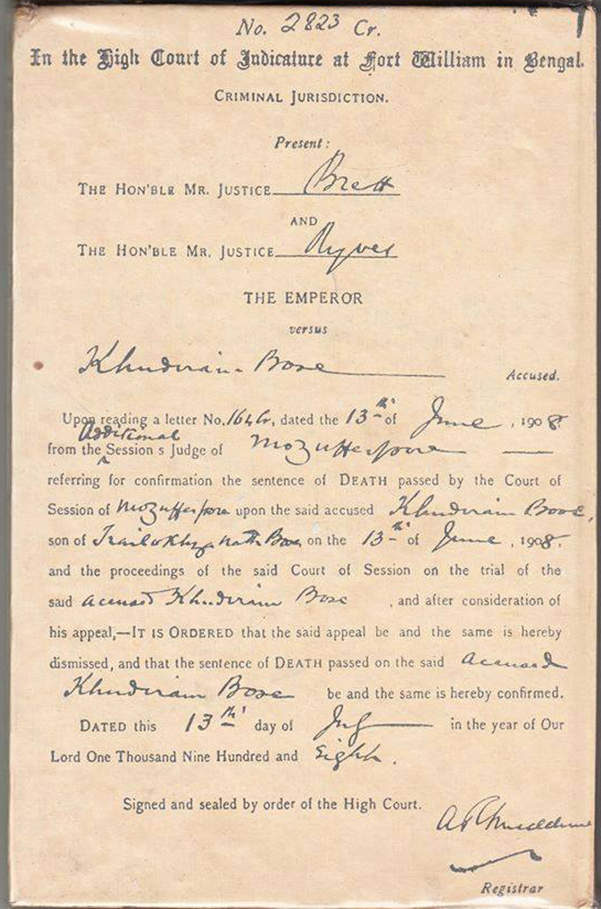
Image Credit : Wikipedia
First published in OpIndia
References
- Bengal Divided by Dr. Nitish Sengupta
- Partition of Bengal
- Freedom movement
- Khudiram Bose

